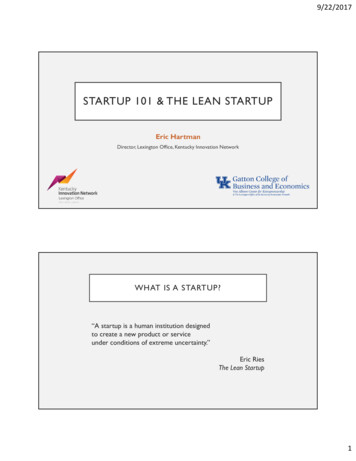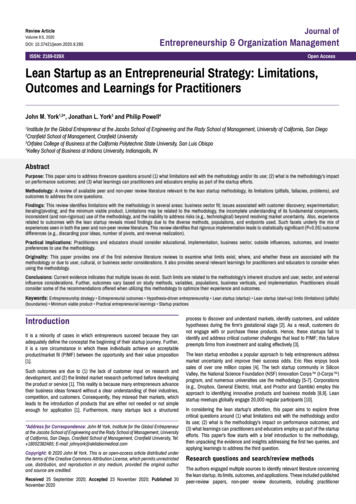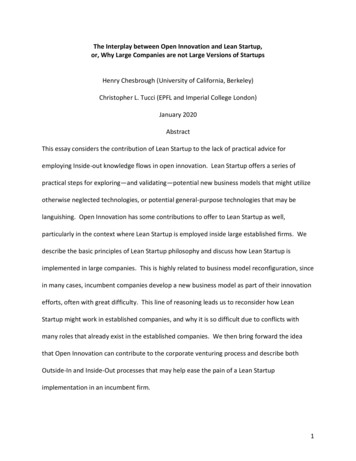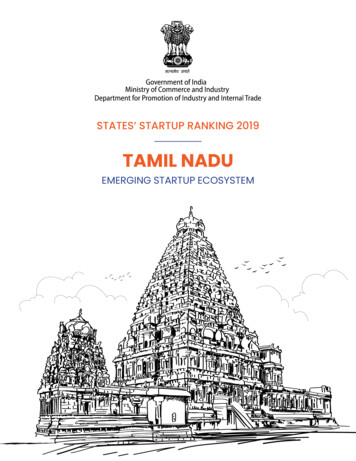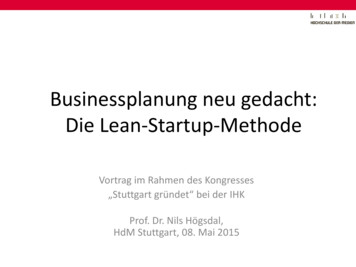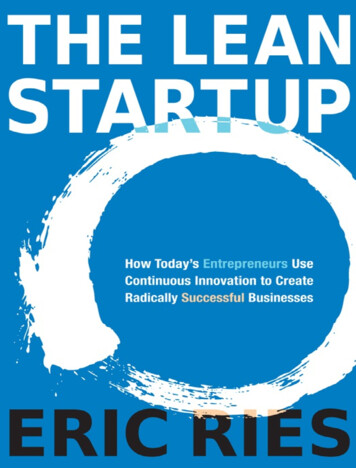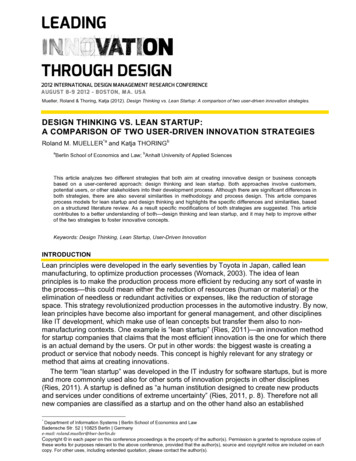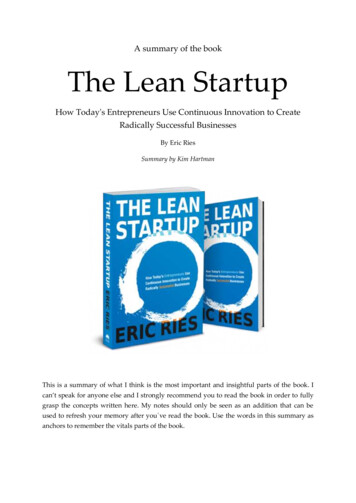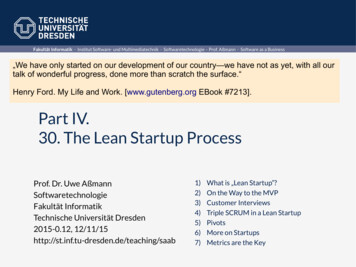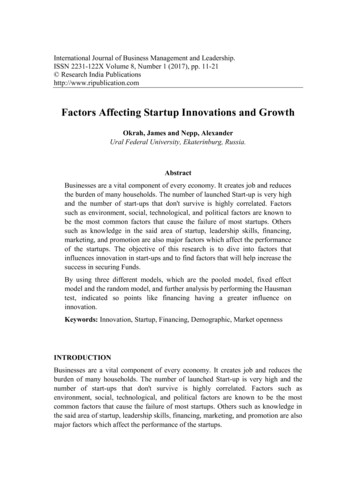
Transcription
International Journal of Business Management and Leadership.ISSN 2231-122X Volume 8, Number 1 (2017), pp. 11-21 Research India Publicationshttp://www.ripublication.comFactors Affecting Startup Innovations and GrowthOkrah, James and Nepp, AlexanderUral Federal University, Ekaterinburg, Russia.AbstractBusinesses are a vital component of every economy. It creates job and reducesthe burden of many households. The number of launched Start-up is very highand the number of start-ups that don't survive is highly correlated. Factorssuch as environment, social, technological, and political factors are known tobe the most common factors that cause the failure of most startups. Otherssuch as knowledge in the said area of startup, leadership skills, financing,marketing, and promotion are also major factors which affect the performanceof the startups. The objective of this research is to dive into factors thatinfluences innovation in start-ups and to find factors that will help increase thesuccess in securing Funds.By using three different models, which are the pooled model, fixed effectmodel and the random model, and further analysis by performing the Hausmantest, indicated so points like financing having a greater influence oninnovation.Keywords: Innovation, Startup, Financing, Demographic, Market opennessINTRODUCTIONBusinesses are a vital component of every economy. It creates job and reduces theburden of many households. The number of launched Start-up is very high and thenumber of start-ups that don't survive is highly correlated. Factors such asenvironment, social, technological, and political factors are known to be the mostcommon factors that cause the failure of most startups. Others such as knowledge inthe said area of startup, leadership skills, financing, marketing, and promotion are alsomajor factors which affect the performance of the startups.
12Okrah, James and Nepp, AlexanderThe objective of this research is to dive into the demographic factors that influencesinnovation in start-ups and to find factors that will help increase the success insecuring Funds.Startups failure and success depend on a countless number of factors, Literature hasidentified one major point which affects startup in their product design, marketing,innovation, and strategies. Financing has been identified as a major factor in thesuccess of most startups. Because of the market crash of 2008, it has been difficult forstartups to come up with financing. Which intends has affected startup innovation.Focused is particularly on the demographical factors that affect innovation in startups.Most startups fail not because they lack financing but because they do not have theforesight and good R&D team. It has been identified that financing is highlycorrelated with good innovation. Many companies were not able to survive becausethey could not keep up with the innovation cap in the market. Innovation can be seenas a survival technique. In 1955, Fortune Magazine listed the 500 largest companiesin a list that’s become synonymous with success. 60 years later, only 71 of thosecompanies still remain.Companies such as Yahoo, Blackberry, Myspace, Border books and the entirepublishing industry are almost forgotten, but in the early 2000s, these were thecompanies others looked upto.In 2005, Yahoo owned 21% of the online advertising market, #1 among all players.Yet today, they’re struggling maintain their #4 position behind Google, Facebook andMicrosoft.Blackberry in the early 2000 held about 50% of the mobile phone market in the worldbut after the release of the iphone they lost their market position total because they didnot understand the swift.LITERATURE REVIEWInnovation is a strong pillar to the success of every startup known in the world,Business that are not able to invest in research and development dies in the strivingmarket. the capital cycle has become the main feature of the innovative market, asindicated by (Gompers and Lerner 2004), (Kaplan and Schoar, 2005), (Gompers,Kovner, Lerner and Scharfstein 2008). (Rhodes-Kropf, M. 2015) indicated that themarket plays a vital role in the financing and financing also has a strong linkage withinnovation. Financing hinders innovation in small scale enterprises in Europe(GhisettiEt al, 2017). (Nanda, R., Rhodes-Kropf, M. 2017) and (Ou, C. 2011) indicated thatstrong financial support for startups can trade off high-level risks. Many businessfailures are mostly attributed to lack of financing, internal market dynamics and lackof innovations. there is a concern over declining innovation in small and medium-
Factors Affecting Startup Innovations and Growth13sized enterprises, most particularly in the case of family businesses(Schäfer, D.,Stephan, A., Mosquera, J.S. 2017). the research indicated the inefficient realization ofinnovative practice by families businesses due to funding in R&D. which means thatif enough financing allocated to such business it will increase their survival andinnovativeness. The gap between innovation and financing seems too difficult toclose as noted by (Czarnitzki and Hottenrott 2011; Mohnen et al. 2008; Canepa andStoneman 2008; Freel 2007). Source of funding of innovative activity becomes theother of the day since there would not be innovation without research.from these, we come up with these set of Hypothesis.1. H1-: Financing is a strong pillar in which innovation thrives.Financing has been identified to have a strong correlation with innovation and successin most startups. it has also been identified to be the best mean to the trade of risk isby high initial investment in startups.H1: Innovation is influenced to a certain level by Internal market Openness:A theoretical model describing the dependence of innovation activity of enterpriseson the degree of competition in the market can also be found in Aghion, Bloom,Blundell, Griffith and Howitt, 2002. (Berger, 2010) in his work he established anempirically positive relationship between competition in the market and innovation.Significant is also the effect of economies of scale and greater ability to raise fundsfor innovative research. openness bring competition and ensures the quality of productand services,H1: Turnover influence the decision of a corporation to be innovative.Innovation has a major effect on the turnover and general growth of companies(Capasso, M., Treibich, T., Verspagen, B. 2015). we want to find out if turnover alsoinfluences the decision of corporation to invest much in R&D.DATA STRUCTUREThe data is a panel data, the countries which are part are all developed countries andthis selection was done looking at the GDP of the various countries. so 13 countriesare considered, that is: Belgium, Canada, France, Germany, Italy, Japan, Netherlands,United kingdom, United States, Switzerland, Sweden, Russia, China. the yearsselected for the analysis was selected because of the availability of data. data was
14Okrah, James and Nepp, Alexanderselected from the year 2006-2015. Missing data are replaced with the mean.The GDPper capita is not presented in percentage but in raw figures to know the actual value indollars.The data below describes the factors considered in the data structure and what eachfactor represent.The GDP per capita is not presented in percentage but in raw figuresto know the actual value in dollars.Models descriptionThe equation for the fixed effects model becomes:Yit β1Xit αi uit [eq.1]Where– αi (i 1 .n) is the unknown intercept for each entity ( n entity-specific intercepts).– Yit is the dependent variable (DV) where i entity and t time.– Xit represents one independent variable (IV),– β1 is the coefficient for that IV,– uit is the error termAnother way to see the fixed effects model is by using binary variables. So theequation for the fixed effects model becomes:Yit β0 β1X1,it β kXk,it γ 2 E 2 γ n E n uit [eq.2]Where–Yit is the dependent variable (DV) where i entity and t time.–Xk,it represents independent variables (IV),–βk is the coefficient for the IVs,– uit is the error term–En is the entity n. Since they are binary (dummies) you have n-1 entities included inthe model.– γ2 Is the coefficient for the binary repressors (entities)
Factors Affecting Startup Innovations and Growth15The random effects model is:Yit βXit α ( uit ui )– Yit is the dependent variable (DV) where i entity and t time.– Xit represents one independent variable (IV)– α is the unknown intercept– uit is the error termPost education(6)Financing (2)Basic 5001.4802.1701st 8022.5642.1282.8923rd 03.9603.7003.0703.710Std DevMax2015Taxes(4)YearGovernmental supportand policies(3)Descriptive Statistics
16Okrah, James and Nepp, AlexanderContinuation of Descriptive StatisticsR.d(7)Internal market dynamics(8)Internal market openness(9)cultural and social norms(10)GDP per 35155.531st 583rd Qu2.7283.0472.8653.0254601173.57Std 91559Max3.7303.9203.6504.1206255780.20Correlation .400.580.57121.00
Factors Affecting Startup Innovations and Growth17The above table shows the summary of all the factors which are considered in theresearch.Table xr.d newOneway(individual)effect WithinModelOneway (individual) effectRandom Effect Model(Amemiya'stransformation)(Intercept)Pooling e-02)governmental support 00362893)1.0607e-02**(3.6448e-03)post education0.00123711(0.00387672)0.00318249 (0.00374367)9.1690e-03*(3.8721e-03)internal market 16615 (0.00015795)-9.5977e-05(1.8239e-04)Adj. R-Squared0.435740.510330.57373theta0.5676Hausman Testdata: y xchisq 15.477, df 5, p-value 0.008507alternative hypothesis: one model is inconsistentFrom the Hausman Test above, the appropriate model to be used is the One Way(individual) effect Within Model (Fixed Model)
18Okrah, James and Nepp, AlexanderMODEL WITH DUMMIESr.dOneway(individual)effect Within ModelOneway(individual)effect Random EffectModelPooling 01 3.8586e-01governmental support and policies1.7199e-01*02)post education5.7325e-02 (7.8335e-02)internal market openness3.4897e-01*** (8.5494e- 3.1042e-01***02)028.4832e- 2.2503e-01*(9.1789e-02)Financing3.5590e-01*** (8.7421e- 3.0036e-01***02)027.8848e- 2.3381e-01*(1.1116e-01)Turnover-1.7438e-02** (5.8830e- -3.4795e-03 3.0784e-0303)-1.0856e-02(7.6100e-03)Adj. R-Squared0.535540.60847theta(7.3691e- 1.9298e-01** 7.3328e-02-1.1049e-01(4.6878e-01)1.0251e-01 297e-01*(9.5114e-02)
Factors Affecting Startup Innovations and Growth19HYPOTHESISSTATUSFinancingSupported By all the modelsPost EducationSupported by just Fixed Effect ModelInternal Market OpennessSupported by all with modelsModel:r.d 1.7199e-01*X1 5.7325e-02*X2 3.4897e-01*X3 3.5590e-01*X4 8.7421e-02)(5.8830e-03)governmental support and policies X1post education X2internal market openness X3Financing X4Turnover X5Hausman Testdata: y xchisq 16.617, df 7, p-value 0.02004alternative hypothesis: one model is inconsistentDISCUSSIONSThe literature brought into light a lot of interesting factors of innovation. In Table x,we used R.D NEW as our independent variable. the first hypothesis was satisfiedwith a very strong t-value, which indicated that financing influences innovations.
20Okrah, James and Nepp, Alexander(Schäfer, D., Stephan, A., Mosquera, J.S. 2017) indicated that family businesses arenot innovative because they lack financing. this research finding confirms theirfindings. This means that for a startup to be innovative, financial support is veryrelevant. many startups exit the market because of bankruptcy, lack of financing doesnot help them bring out a new innovative product and services, that means thosecompanies that have the ability to support research activities tends to be the onesalways leading the market. this also makes something companies dominate a givenmarket for a longer period of time. Financing can be said to be the pillar behind everysuccessful startup.The second hypothesis is Innovation is influenced to a certain level by Internal marketOpenness, this was seen to be positive with the Fixed effect model in table x. thisconfirms another finding by (Berger, 2010), which stated that openness of the marketcreate competition which intends makes leaders focus much on innovations. as themarket is open, it attracts a lot of participants, which create the atmosphere forinnovation and development. when there is no competition, leaders becomes reluctantwith the creativity. Like the case of Nokia, because there was a high competition onthe smartphone market, those companies that still lived in the past were left behind.Facebook is still Facebook after a decade because they understand the competitionand always tries to kill the competition, Facebook buying WhatsApp because theyrealized people were switching their attention to WhatsApp at the time of purchase.Openness keeps good leaders on their toes, which wakes their innovative instincts.competition is good for every economy.It was realized that turnover did not have any influence on the innovation of startups.REFERENCE[1]KAPLAN, S. N. and SCHOAR, A. (2005), Private Equity Performance:Returns, Persistence, and Capital Flows. The Journal of Finance, 60: 1791–1823. doi:10.1111/j.1540-6261.2005.00780.x[2]Gompers, P., Kovner, A., Lerner, J., Scharfstein, D., 2008. Venture capitalinvestment cycles: the impact of public markets. Journal of FinancialEconomics 87, 1–23.[3](Rhodes-Kropf , M). Is the VC Partnership Greater than the Sum of itsPartners? /(M. Rhodes-Kropf) [Journal of Finance, 2015[4]Ghisetti Et al, (2017). Financial barriers and environmental innovations:evidence from EU manufacturing firms. Climate Policy17, pp. S131-S147[5]Ou, C. (2011) Statistical databases for research on the financing of small andstart-up firms in the united states: An update and review ( Book Chapter)Advances in Entrepreneurial Finance: With Applications from BehavioralFinance and Economics pp. 219-250
Factors Affecting Startup Innovations and Growth21[6]Schäfer, D., Stephan, A., Mosquera, J.S. 2017 Family ownership: does itmatter for funding and success of corporate innovations? Small BusinessEconomics 48(4), pp. 931-951[7]Czarnitzki, D., & Hottenrott, H. (2011). R&D investment and financingconstraints of small and medium-sized firms. Small Business Economics, 36,65–83.[8]Mohnen, P., Palm, F.C., Van Der Loeff, S.S., & Tiwari, A. (2008). Financialconstraints and other obstacles: are they a threat to innovation activity? DeEconomist, 156, 201–214.[9]Canepa, A., & Stoneman, P. (2008). Financial constraints to innovation in theUK: evidence from Cis2 and Cis3. Oxford Economic Papers, 60, 711–730.doi:10.1093/oep/gpm044.CrossRefGoogle Scholar[10]Becker, G. (1975).Human Capital: A Theoretical and Empirical Analysis, withSpecial Reference to Education, Second Edition.National Bureau of EconomicResearch, Inc[11]Capasso, M., Treibich, T., Verspagen, B. 2015 The medium-term effect ofR&D on firm growthSmall Business Economics45(1), pp. 39-62[12]Berger, V. W. (2010), Making statistics boring again. Statist. Med., 29: 1458.doi:10.1002/sim.388
22Okrah, James and Nepp, Alexander
success of most startups. Because of the market crash of 2008, it has been difficult for startups to come up with financing. Which intends has affected startup innovation. Focused is particularly on the demographical factors that affect innovation in startups. Most startups fail not because they lack financing but because they do not have the
